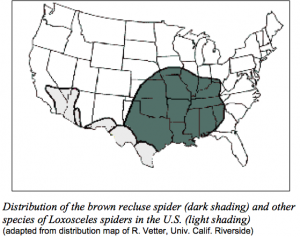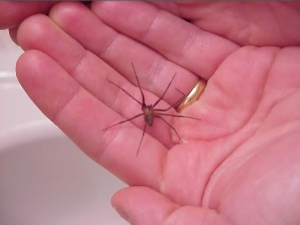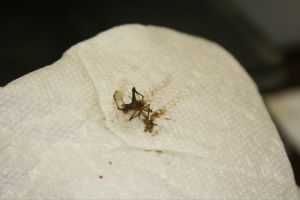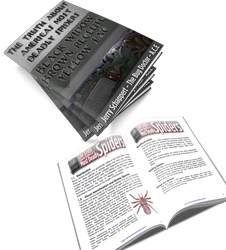In the spider-web of facts, many a truth is strangled.”
Paul Eldridge
The brown recluse spider is indeed something to be wary of and treated with respect. The wounds that can result from this arachnids venom is something that often does last a lifetime in the form of horrid memories, lasting fears and visible scars. In reality however, the recluse bite is more often misdiagnosed by physicians, mis-reported by the media, mistaken by the public and over hyped on the world wide web.
The brown recluse is indeed a hearty species that can go up to 6 months without out food or water, it can survive harsh conditions such as cold basements in the winter or the blistering heat of the attic in the summer. This spider is also transported quite often out of its region in moving vans or deliveries hidden away in a box or piece of furniture. So with all this going for it one would assume that the thousands of reports, sightings and diagnoses would have merit and that the sometimes wide spread panic is based on cold hard facts. The ‘facts’ however do not bear this out.
Brown recluse spiders get their name because of their habit of hiding in out of the way places and preferring to steer clear of any real contact with man or beast. This nocturnal hunter only ventures out for food and usually spends its day back in the secluded nest or lair where it will rest.The recluse eats other bugs of course as spiders do but the brown recluse will dine on both living and dead insects which is not so common in the spider realm. Other spiders are actually their biggest enemy such as cellar spiders or even other hunting arachnids like the wolf and jumping spiders.
The nest is usually lined with irregular webbing and this is mostly for the females egg sacs and no webs are used in trapping prey. The female does not roam or hunt nearly as much as the adult or juvenile males. Only about 40 or 50 baby spiders are contained in the small off white sacs (about 1/3 of an inch and circular shaped) and they grow by molting or shedding their skins. This process continues for about a year and they will have molted up to 8 times. The shed skins are noticeably rigid and are an excellent way to determine this spiders presence in a home.
female does not roam or hunt nearly as much as the adult or juvenile males. Only about 40 or 50 baby spiders are contained in the small off white sacs (about 1/3 of an inch and circular shaped) and they grow by molting or shedding their skins. This process continues for about a year and they will have molted up to 8 times. The shed skins are noticeably rigid and are an excellent way to determine this spiders presence in a home.
A full grown recluse will be about the size of a quarter and will live anywhere from 2 to 4 years. The female may produce up to 5 egg sacs in her lifetime. Colors often vary and are no credible way to identify the recluse. The distinct marking of a violin or fiddle shape on their top side is the common way to distinguish the spider but can easily be confused with other spiders who have similar markings. To positively id this spider you must have a magnifying glass and count the eyes. Recluse spiders only have 6 eyes in a semi circle pattern, 3 groups of 2. All other spiders as you may know have 8 eyes and the patterns can vary widely.
 This small spider is not aggressive and incapable of biting through clothing. Bites occur mainly from the males who have ventured into shoes or on to a bed and when they feel the pressure of the persons body rolling on them or pressing into the article of clothing and they respond with a bite. The bites themselves are seldom felt but in 3 to 8 hours the site may become red, swollen and tender to touch. The majority of the recluse bites heal with no medical intervention in a few weeks but at times the necrotic toxin lingers and continues to destroy tissue. The wound may become bluish with a pale center and redness around its irregular shape. A blister often forms in the middle of the wound and this site may now take many months to heal and leave behind a nasty scar. Victims may also become dizzy,
This small spider is not aggressive and incapable of biting through clothing. Bites occur mainly from the males who have ventured into shoes or on to a bed and when they feel the pressure of the persons body rolling on them or pressing into the article of clothing and they respond with a bite. The bites themselves are seldom felt but in 3 to 8 hours the site may become red, swollen and tender to touch. The majority of the recluse bites heal with no medical intervention in a few weeks but at times the necrotic toxin lingers and continues to destroy tissue. The wound may become bluish with a pale center and redness around its irregular shape. A blister often forms in the middle of the wound and this site may now take many months to heal and leave behind a nasty scar. Victims may also become dizzy,
nauseous, run a fever, have cold chills or a rash in the early stages of the bite and this is far more common in young children. If bitten by a recluse the person should apply ice, elevate the wound and seek medical attention immediately.
It is very difficult to positively diagnose any spider bite wound without a specimen and the recluse is no different. Yellow sac spiders also deliver a necrotic venom which is often mistaken for the recluse, even by Doctors. Other wounds such as bed sores, diabetic wounds, gangrene and even fungal infections look and act very much like the spiders bite. You must try and verify the culprit and even if the specimen is smashed and in pieces, take the spider with you so it can be looked at. A pest professional can also inspect the home or area and look for clues to help in this vital identification even if they cannot find the actual spider. Far too many bites and wounds have been attributed to the brown recluse and this has caused needless or incorrect treatments and fears.
The range of the recluse is not widespread throughout America although as stated they can occasionally hitch a ride and end up outside of their known territories. The recluse does not thrive once it has passed its boundaries and it is very rare that they would become established in such areas. There are other Loxosceles (other types of recluses) that live beyond this range but the Loxosceles reclusa (brown recluse) simply does not. Their range is from the southern midwest states to the Gulf of Mexico and as far as western Georgia up to parts of Kentucky.
(other types of recluses) that live beyond this range but the Loxosceles reclusa (brown recluse) simply does not. Their range is from the southern midwest states to the Gulf of Mexico and as far as western Georgia up to parts of Kentucky.
Pest control treatments for any spiders can be difficult and the recluse is no exception. Professionals should always be called in for this task. The use of dusting materials to voids, cluttered and undisturbed areas can work well while flat glue boards are used along garage walls or suspected areas. Outside the recluse will live in wood piles, under rocks or landscaping and the use of power spray equipment may be the most efficient for their control. If a home is known to have the recluse, special care should be taken when putting on shoes or clothing that may have the recluse. Inspect and shake the articles to dislodge any hiding spiders and always wear gloves if cleaning out the garage, attics or any area that has been left alone for anytime making it the ideal place for this spider to nest.
 The truth about Americas most deadly spiders” is a free e-book which you can choose to download and read at your leisure. Simply sign up for my also free newsletter and it’s your to keep. This is the first of many detailed writings that I have planned and I truly hope that you’ll enjoy it and use the information to keep your home spider free. If you missed the sign up box when you logged onto my site simply fill out the newsletter request form at the right of this page and shoot me an e-mail and I’ll get it right to you.
The truth about Americas most deadly spiders” is a free e-book which you can choose to download and read at your leisure. Simply sign up for my also free newsletter and it’s your to keep. This is the first of many detailed writings that I have planned and I truly hope that you’ll enjoy it and use the information to keep your home spider free. If you missed the sign up box when you logged onto my site simply fill out the newsletter request form at the right of this page and shoot me an e-mail and I’ll get it right to you.
Information is a powerful thing and I hope together we can put to rest any undue arachnophobia’s.
Grab Your Free Copy Below




